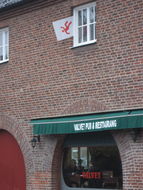
Mior
Excursion map
Skånebilder
Lund
Livets museum
Photo album
Slideshow
Pictures:
16 November 2012
To the left
Entrance
Elongated
Hearts
Skeletons
Naked
Skinless
Leg prostheses
Spare parts
Creative
Strapped
Skin size
My skin
Giddiness
Ear
Pieces
Artificial
Precipice
Play area
Dialysis
Ultrasound
Read more>>
Naturguiden
Skånetrafiken
 Livets museum
Livets museuma nice little elongated and narrow Museum in Lund. Medical history and how our body works.
November 16, 2012: It's not just a medical history museum, but also about how our body works, and rather playfully presented. It is housed in former hospital buildings. The entrance is hidden. If you stand at the crosswalk at Valvet across the street, and see the University Library, it is to the left. If one expects operating theaters and a variety of medical instruments one will be disappointed. So much can not fit in the 130 meters long and 3 meters wide building along the Allhelgona kyrkogata, one hopes to take over more space. It has a play area for children, where they can play hospital. The corridor ends with the interior of an old drugstore. There are not many people who find their way here, I get a guided tour just for me.
Heart and motion
I see how the artificial heart was developed. On a monitor shows how
ultrasound let us see the heart beating. Not long ago, I saw my own
heart that
way. On a wall hang bone prostheses, today not similar to a true
leg, and one
can play sports with them. A play of light and real skeletons of
cat,
monkey, flying fox, seal, show that vertebrate skeletons are
similarly
structured. Adjacent is a model of the human skeleton. All the same,
but
adapted to different life. a light cat skeleton becomes a cat that
jumps up, elastic
and smooth movements. A skeleton shows which parts you can be
replace in man, in
the booth next to it are various ball joints.
Eye, ear, skin, structure, aging
EReader gives more information, point it at a picture and you can
e.g.
"Dress" of a naked woman (or man, I chose the woman of course). Take
off the skin,
..., in the end all that remains is the brain. I dress her again,
the woman is
more beautiful with the skin on. Skin is a big organ, a mirror show
how big,
I get to see my own enlarged. It shows how you can trick the eye and
brain
with optical illusions. So far, my hearing good, the eardrum and the
small
pieces that transmits eardrum movement into the brain works. One can
measure
your own hand strength, 550 N with the right hand, 450 with the
left. Pretty
good according to the guide. A
little about the brain, mine has gotten worse. It was quite a long
time since
conception now, and I get older. Both illustrated on monitors, with
an artificial
insemination. An age staircase crosses the corridor and ends with
you falling
out the window precipice.
The brain
The brain is a remarkable thing. We know somewhat what the different
parts do
and how. Very much is still unknown, but the knowledge is built on.
The
psychological knowledge has not developed as fast. It is not so long
since we
strapped patients. Many were creative people, there are some works
of St. Lars
former museum.
Ultrasound and dialysis
Lund has some medical innovations. Hellmuth Hertz, a
professor in Lund, co-developed the method of using ultrasound to
study the
heart (he is also behind the inkjet printer). Nils Alwall, professor
of Lund,
developed the artificial kidney for dialysis. Both devices are shown
at
the museum.
Reflections
There is a small shop, buy a piece of organic chocolate as fuel for
the ride
home. Thinking about that life and the universe is amazing. Life has
a
self-regulating adaptation to changes in the environment on our
planet. If I
were God, I would have been proud of my creation. Remains to be seen
whether
life can cope with man's present destructive impact on the
environment.
Link: Livets museum
